Vpcs
A service that allows users to create their own private network in the AWS cloud
- Main purpose is to enable you to manage network traffic between certain AWS services and the internet
- It helps to group and structure instances
- You can group multiple instances into one or more VPCs
- You can have multiple VPCs, and every VPC contains possibly multiple EC2 instances
- Motivation/Scenario
- diagram
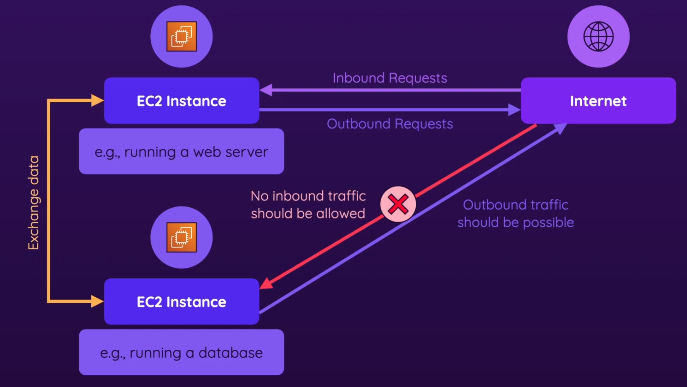
- Let’s say you have 2 EC2 instances, one is a webserver and one is a database
- For an extra layer of security, if you have an EC2 instance that you don’t want to be able to receive requests from the internet (like a EC2 database), you might want to not just block incoming requests, but make it not have ANY connection to the internet at all through these requests might be incoming
- You want to have detailed control over which instances are connected/disconnected to the internet in which way
- diagram
VPCs
- diagram
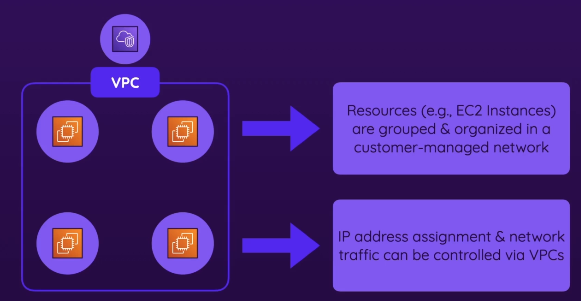
- You can control network settings for those VPCs on a group level
- IP address assignment
- Actual network traffic, whether instances are connected to each other and/or the internet AT ALL
- Not talking about blocking requests, but about the connectivity of instances
- You choose a region when creating a VPC
- It is a regional service
- When making a new VPC check the region in top left (in general, if you can select a region in top right corner, it matters for that service)
- Most used case for VPCs
- EC2 instances (which needs VPCs in order to be launched) (most popular)
Subnets
- diagram
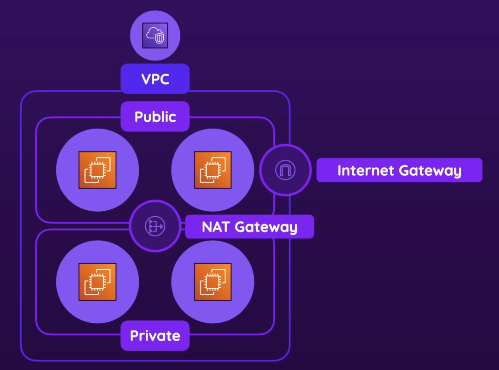
- Inside VPCs, you group your instances into subnets
- It’s actually these subnets where you control:
- All instances in one VPC can talk to each other no matter if they’re in the same subnet or not
- NAT gateways
- let private subnets reach external services securely while keeping them off the public internet for inbound traffic
Gateways
- NAT Gateway
- Network Access Translation
- Allows private subnets indirect internet access through the internet gateway, but ONLY for outgoing requests
- Internet gateway
- when building a VPC, you can choose to add this to the VPC, then connect certain subnets to that internet gateway
- public subnets MUST have this: Without this, instances in the public subnet cannot reach or be reached from the internet
Creating a VPC
- Preview

- You start with 1 default VPC per region
- Your VPCs > Create VPC
- option:
VPC and more - Choose # of AZs and which AZ you want (in ur current region)
- Choose # of private/public subnets
- You can add a NAT gateway (paid)
- Route tables
- Details for network requests in/out the VPC are controlled here
- set up automatically
- tells AWS how to forward incoming requests whether its from one instance to another instance, or if they’re incoming from the internet
- Network connections
project-igw: an internet gateway connected to public subnets
- VPC endpoints
- DNS options
- Make sure that instances that are added to the subnets here will automatically get host/domain names assigned to them
- default domain names assigned
- you can assign ur own later
- option:
Connecting Subnets & EC2 Instances
- Related: EC2 Configuration
- Subnet connectivity VS firewall settings (
Network Settings > Edit)- Subnet connectivity - whether an instance can access the internet or other resources within a VPC (public or private)
- firewall settings (such as Security groups and NACLs) - control the specific traffic flow to and from instances, defining which traffic is allowed or denied based on IPs, ports, and protocols.
- The Security groups define which kinds of requests can be sent between instances in a VPC
- Ex) An instance in a private subnet can receive HTTP requests from other instances but not the internet
VPC Peering & Transit Gateways
VPC
Allows connectivity between two VPCs
- diagram
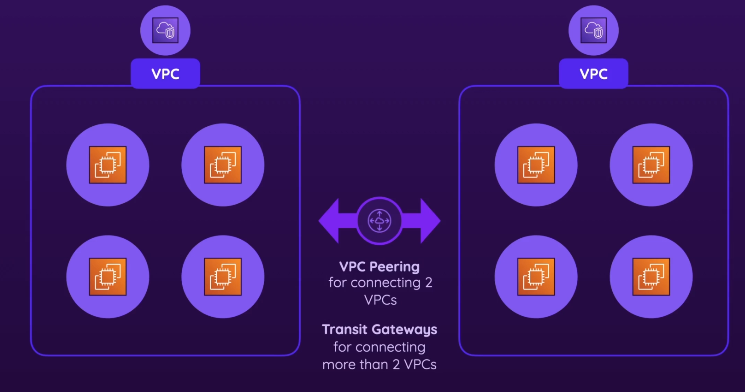
- VPC Console > Peering Connection > Create Peering Connection
VPC Endpoints & AWS PrivateLink
- diagram
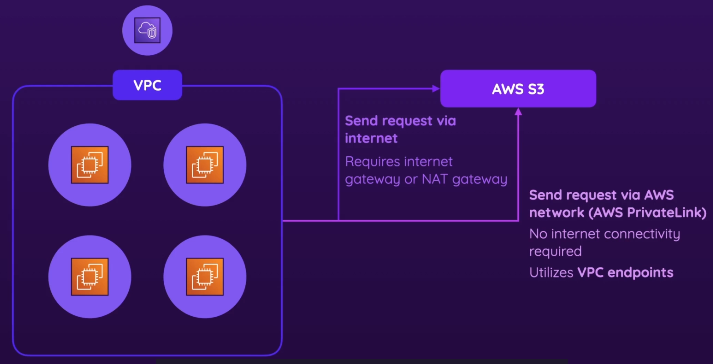
- When you want to connect your instances to another AWS service (2 ways)
- Via internet
- Via AWS network (AWS PrivateLink)
- PrivateLink
- Doesn’t require internet connectivity
- Set up VPC endpoints
- VPC console > endpoints
- If you have an endpoint created, AWS will automatically use it when you send a request to a fitting service
- Ex) If you created an S3 endpoint for a given VPC, if an instance in that VPC sends a request to S3 it would use this endpoint
- eliminates NAT Gateway data processing fees for in-region S3 access
(monitoring) VPC Flow logs
- can record IP-level network traffic for interfaces and subnets, including the NAT Gateway’s elastic network interface
- tracks traffic generated in the VPC
- you see which private IP (i.e., your instance) is generating large outbound data, helping pinpoint unexpected cost drivers
- data is aggregated and put into a CloudWatch log group
- related: Monitoring workloads